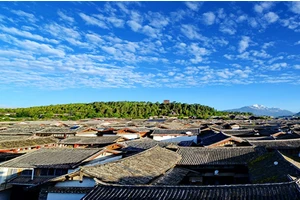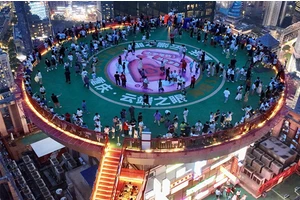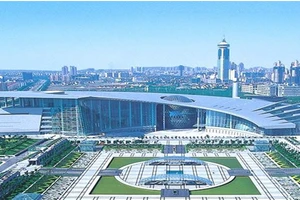Sansu Temple Tourism
Meishan Sansu Temple is a very popular tourist attraction, among which there are many scenic spots worth visiting by friends. Then let's take a look at how to visit Meishan Sansu Temple in one day! See below for details.
First, the tour route
Sansu Memorial Hall: Multifunctional Hall → Preface Hall → Su Xun Exhibition Hall → Su Shi Exhibition Hall → Su Zhe Exhibition Hall.
Sansu Temple: South Gate → Front Hall → West Wing → Fandian → Left Wing → Right Wing → First Half of East Wing → Second Half of East Wing → Qixiantang → Suzhai Ancient Well → Express Rain Pavilion → Mozhuang → Murockery Hall → Yunyu Building → Laifengxuan → Portrait of Dongpo Pantuo in Cape Pavilion → Lian 'ao Mountain → Baniang Companion.
Second, the opening hours
Sansu Temple: Tickets are closed at 9:00-18:00 and 17:30.
Sansu Memorial Hall: Tickets will be closed at 9:00-18:00 and 17:30 from Tuesday to Sunday (it will be closed every Monday for maintenance of equipment and facilities, except for legal holidays and special circumstances).
Third, the ticket price
Sansu Temple: 40 yuan/person? time
Children: under 1.3m in height, free of charge.
Old people: national holidays, the elderly over 65 years old are open [free], and they can go to Sansu Temple Visitor Center with their ID cards to get free tickets; Non-national statutory holidays, the elderly over 60 years old [free] open, with my ID card to the Sansu Temple Visitor Center to receive free tickets.
Disabled people: with disability certificate, free of charge.
Military personnel: with military officer's card, free of charge.
Students: Full-time primary and secondary school students with student ID cards, half price.
Sansu Memorial Hall: Free tickets with valid certificates.
Fourth, the traffic guide
Address: No.72, South Section of Shapihang, Dongpo District, Meishan, Sichuan.
Bus route: Get off at Sansuci No.8, get off at Sansuci West on No.1, 2 and 11, and get off at Sansuci South on No.3, 11, 16 and 19.
Self-driving route:
1. Chengdu and Leshan: Jingkun Expressway/Chengya Expressway → Chengle Expressway to Meishan City, and drive along Pumei Road → Jinxiang Avenue → Suci Road.
2. Ya 'an and Ziyang: Suizimei Expressway → Chengle Expressway to Meishan City, and drive along Pumei Road → Jinxiang Avenue → Suci Road.
There are many tourist attractions in Sansu Temple, which is a tourist attraction worthy of friends to play and punch in! Then let's take a look at the scenic spots in Sansu Temple. See below for details.
1. Hongsha Ancient Bridge
Bridge is an important landscape element in Sansu Temple Garden. The water in the garden is in harmony with the bridge, which makes it a landscape. In the past, Sansuci Park had 23 garden bridges of all kinds, and then six were rebuilt with red sandstone.
2. Holding the Moon Pavilion
Baoyue Pavilion, built in the first year of Guangxu (1875), is a double-deck roof with a pointed roof. The pavilion is named after Su Shi's "Former Red Cliff Fu", which "mourns my body for a moment and envies the infinity of the Yangtze River. Take the flying fairy to travel, hold the bright moon and end up ".
3. Yunyu Building
Yunyu Building was built in the first year of Guangxu in Qing Dynasty (1875) when Zhang Zhidong, the inspector of Sichuan Province, arrived at Mei. The south, west and north of the building face the water, and thousands of poles and bamboos embrace each other. The building introduces the change and repair history of Sansu Temple.
Qixiantang
Qixian Hall was built in the reign of Kangxi in the Qing Dynasty (1665). It is a memorial hall dedicated to the ancestral shrine of the Su family, which is a metaphor for connecting the past with the future and bringing together people with virtue and talent.
4. Wanxiangtang
Wanxiangtang, located at the northern end of Dongyuan, is a building with a floor area of about 634 square meters, which displays the fine cultural relics in our library and the editions and rubbings of Su Shi's poems and poems in Song, Yuan, Ming and Qing Dynasties. The building was named after the rubbing of Su Shi's ink in Chen Jiru in the Ming Dynasty.
5. Sansu Memorial Hall
The Sansu Memorial Hall covers an area of more than 2,000 square meters. The exhibition is divided into ten parts: the Su's preface hall in Meishan, the famous capital, the official career, the brilliant and outstanding literary achievements, the model of Li Min, the rare prodigy in the world, the Millennium hero who influenced later generations, Su Xun's life and his literary achievements, Su Zhe's life and his literary achievements, and Meishan's history and culture.
6. Wooden rockery hall
The Murockery Hall was built in 1666, the fifth year of Qing Emperor Kangxi, and rebuilt in 1755, the nineteenth year of Qianlong. According to "Meishan County Records", Su Xun occasionally got three wooden fake peaks, bought them at home, and wrote the article "Murockery". Su Xun personifies the luck and misfortune of the wooden rockery, and his lovely and respectable life as a symbol of perseverance. Three peaks of wooden rockery: a metaphor for the three Soviet fathers and sons. Poets Mei Shengyu, Su Shi and Lu You all praised it. The existing wooden rockery in the hall was donated by Li Menglian, the lecturer of Meishan Academy in the 12th year of Daoguang (1832).
7. Cape Pavilion
In Song and Wei Dynasties, Weng was the guardian, and it was surrounded by the lake because of the dredging of the old marsh (so the address is in the area around the lake road in Meishan County today). There is a cloak pavilion with a portrait of Dongpo painted in it. ("Meishan County Records") During the Chunxi period of the Southern Song Dynasty, the poet Lu You came to Meizhou, once traveled around the lake, boarded the cloak pavilion, paid tribute to Dongpo's portrait, and wrote the poem "Meizhou's cloak pavilion worships Dongpo's portrait": "Looking back on the mountains, the Shili River is flat and silent. Pregnancy and beauty are here, and Yuran has a thousand years of poetry and book city. " In the 24th year of Guangxu reign in Qing Dynasty (1898), Meizhou built this cloak pavilion in Sansu Temple to commemorate Su Shi, Wei Liaoweng and Lu You.
Gujing introduction: The drinking well of Sansu's father and son's family, which is more than 1000 years ago, is the only relic left by the Su family. The wellhead is 50 cm in diameter and approximately circular. The well edge is about 20 cm wide, and some well edges have been damaged. The well is about 7 meters deep and nearly 4 meters deep. Well water is refreshing and sweet, and it will not dry for many years. If you drink this magical well water, it will definitely make your ears bright and your eyes bright, and you will be imbued with the aura of a writer.
8. Xiyan Lake
A small water pool in the old home of Su family is a place where Su Shi brothers and teenagers learn to paint and wash pens and inkstones. Later generations named it Xiyan Lake in memory of Sansu's father and son. At the end of the Qing Dynasty, the inscription "Xiyan Lake" was engraved on the wall of the pond in Meizhou.
9. Litchi tree
A dead 900-year-old litchi tree has a circumference of about 2 m 2, a root system diameter of more than 2 m at the bottom and a color close to bordeaux.
10. Monument Gallery
The building area of the stele gallery is about 507 square meters, which consists of five pavilions and galleries in an "N" shape. There are stele pavilions and drunken pavilions in the East Gallery, stele pavilions and Fengle pavilions in the West Gallery, and loyalty pavilions in the South Gallery.






